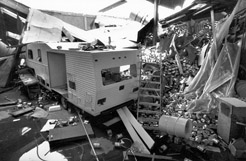
Stricter engineering codes implemented after big quakes may mean
less damage in future temblors
Many of the unreinforced masonry buildings in downtown Hollister
either crumbled to the streets or were irreparably damaged during
the Loma Prieta quake in October 1989.
Stricter engineering codes implemented after big quakes may mean less damage in future temblors
Many of the unreinforced masonry buildings in downtown Hollister either crumbled to the streets or were irreparably damaged during the Loma Prieta quake in October 1989.
The buildings that replaced them are considered much more structurally sound, though no one can predict exactly how any building will react in an earthquake.
“You can never tell what an earthquake is going to do,” said city of Hollister building official Greg Johnsen. “But every time there is a large earthquake, codes are modified as we learn more and more about buildings and how they react to shaking.”
The local buildings that suffered the worst damage in Loma Prieta were built decades before the ideas of earthquake retrofitting and computerized structural stress tests impacted design.
They were brick and mortar – a popular construction method at the time but now an acknowledged danger in earthquake zones such as San Benito County, which lies in an area with the most restrictive quake safety building requirements.
“Unreinforced masonry does not happen anymore in this area,” Johnsen said. “Buildings are now structurally engineered according to their seismic area zone.”
Concerns remain about what a particular quake could do to any structure, regardless of when or how it was built.
“If a structure is built and inspected properly, it shouldn’t have a problem [withstanding an earthquake] to a certain magnitude,” Johnsen said, noting how high-rise buildings in San Francisco escaped damage in Loma Prieta while homes in the Mission District crumpled.
In the past 20 years since Loma Prieta, seismic engineering of homes has become a requirement for new construction, according to building officials.
“Twenty years ago there were hold-downs usually by the walls in a garage” on new construction, Johnsen said. “Now you have straps running across the tops of roofs and throughout floors. Sometimes there are hold-downs between floors and the foundation is tied to the roof structure for earthquake protection. I remember back then [in 1989] you didn’t have to even have water heaters seismically strapped.”









